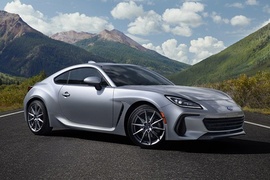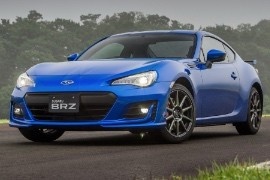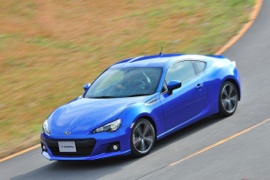
SUBARU BRZ
Generations Timeline, Specs and Pictures

Subaru refreshed its BRZ model and gave it more punch and a full technological pack to enhance the little coupe.
In 2012, Subaru and Toyota introduced their common project for a sports car coupe. It was sold under three names: Subaru BRZ, Toyota GT86, and Scion FR-S. The latter was dropped when the Japanese sub-brand collapsed, but the other two models survived. It was a joint project where Subaru brought its flat-four engine, and Toyota made the bodywork. Soon after its launch, the customers started to ask for more power, but it was difficult to offer something more.
Following the same recipe as most of the facelifts on the market, the 2021 BRZ featured a new bumper design and a new pair of headlights. Due to the wider grille in the front apron and the vertical side-scoops from its bumper, the car looked wider—a new LED daytime running light system with a J-signature enhanced the car’s appearance. The BRZ featured a new set of taillights and a small ducktail on the tailgate in the rear.
Inside, Subaru decided to introduce a fully digital instrument cluster with a TFT display instead of analog dials. It could show various information such as G-forces, revs per minute, speed, oil pressure, coolant temperature, amp-meter, and speed. On the center stack, Subaru placed the 6.2” infotainment unit named Subaru Starlink.
Under the hood, there was a choice of two engines, depending on the market. The 2.0-liter flat-four was upgraded with various internal components and provided 205 hp. The top version was powered by a 2.4-liter, which offered 228 hp. Both versions were paired as standard to a 6-speed manual, and a new 6-speed auto was on the options list.

The Subaru BRZ coupe received an update for 2017, coming with slightly sharper looks, improved handling, and new convenience features.
Design wise, the front bumper has been redesigned for improved aerodynamics and stability. The daytime running lights are now part of the headlight design, which is also full-LED. The rear gets a slightly reshaped bumper and new LED stoplights. The interior comes with an updated instrument cluster, redesigned HVAC control panel and a grade level reshuffle. A performance package is now available coming with Brembo calipers and larger rotors, SACHS shock absorbers as well as uniquely-designed 17-inch rims.

The BRZ was a joint program between Subaru and Toyota and it was often named as Toyobaru or Subyota.
Whichever works. But the result was a great handling car, designed for smiles per miles.
Toyota tried to make a comeback on the fun-to-drive car category. After it cut the Supra, the all-wheel-drive Celica and the MR2, it didn’t have any other vehicle to bring a smile on the petrolheads’ faces. Subaru, on the other hand, didn’t have the financial power to develop such a complex program of a new sports-car. A deal was signed and the Subaru BRZ / Toyota GT86 / Scion FRS was born.
The low front end of the car was Subaru’s merit. The flat-four engine was shorter than any other inline-four unit. Since the front end was short, the whole car seemed longer than it was. A low greenhouse with a raked back accomplished the mission to design a sporty vehicle. There were some styling differences in the car to differentiate it from Toyota, but mainly the badges. The headlights and the taillights were specific for the BRZ and not connected to any design trend followed by the Subaru. The two exhausts were placed on the left and right of the car, on the sides of the center diffuser.
Inside, the low seating position was typical for a sports-car. The dashboard was straight and not tilted toward the driver. Two bulges on top of the dash covered the instrument cluster a two air-vents. Depending on the options, a navigation system was installed on the center stack.
Under the hood, the 2.0-liter Boxer engine was mated to a standard 6-speed manual. An automatic with paddle-shifters behind the steering wheel was offered as an option. Unlike most of the Subaru range, the BRZ was offered exclusively with rear-wheel-drive.























































